ISSN: 0973-7510
E-ISSN: 2581-690X
Soy sauce, a salty condiment with nutrient rich fermented food, has been a popular cuisine in Asian countries like China, Korea, and Japan for thousands of years. Different techniques have been implied to enrich the nutrient potentials of soy sauce. The objective of this study was to enhance the antioxidative value of the soy sauce using enzymatic hydrolysates of roasted Eupolyphaga sinensis (ES), a useful insect in Chinese traditional medicine. The optimal hydrolysis conditions of roasted ES were 300 U/g of arazyme dosage, 4 h of hydrolysis duration, and 1:25 of material/water ratio. The DPPH scavenging activity and peptide content of the soy sauce reached 75.69% and 145.19 mg/mL, respectively, when 8% hydrolysates of ES were added at late-fermentation period. Soluble unsalted solid, amino acid nitrogen, and total nitrogen were reached to 22.1 g/100mL, 0.68 g/100mL, and 1.75 g/100mL, respectively. Free amino acid and element content were increased compared to the control, while sodium content reduced significantly (p<0.05). The results showed that the novel soy sauce fermented with enzymatic hydrolysates of ES was an antioxidant rich high quality product. This study may help food industries to produce a novel antioxidative soy sauce.
Antioxidant activity; Enzymatic hydrolysate; Eupolyphaga sinensis; soy sauce.
Soy sauce is a salty condiment with unique color, aroma, and flavor, as well as nutrient rich fermented food. It has been a popular cuisine in Asian countries like China, Korea, and Japan for thousands of years. Studies have reported antioxidant, hypotensive, and anticancer potentials of soy sauce in addition to adjust the taste1-3. Production of soy sauce in China is more than half of the world4. There are mainly two processes in production of soy sauce in China that include low salt solid state fermentation and high salt dilute state fermentation. Soy sauce made of the former process has advantage of higher production over the traditional process per unit time5. However, it leads to products of considerably poor quality. Furthermore, single species of soy sauce in market cannot meet the market demand.
Eupolyphaga sinensis (ES) is an edible insect having medicinal value in China. Out of the 18 amino acids found in ES, the eight essential amino acids constitute 34.5% of total amino acids6. It is used to treat traumatic injury as traditional Chinese medicine7. It has also been reported to have anticancer, anti-thrombosis, and immunomodulatory properties8,9.
Antioxidant peptides are bioactive peptides which are obtained from protein hydrolysis. A number of research works are paying attention to antioxidant peptides for their advantage of easily absorbable in human and high antioxidant activity10,11. Insects are being studied for their antioxidant peptides properties. A new protease separated from symbiosis microbes in organs of a Korean spider (Nephila clavata) was used to produce antioxidant peptides12. It is a high efficient nature proteolytic enzyme and offers a potential source for protease. In other study antioxidant peptides of ES was found to have good antioxidant potential13.
Different techniques have been implied to enrich the nutrient potentials of soy sauce. Soy sauce has been fortified with various iron sources14 and NaFeEDTA15. Since ES is an edible medicinal insect in China, the objective of this study was to develop a low salt solid state soy sauce supplemented with hydrolysates of roasted ES (HRES) during the fermentation process to increase antioxidant activity and improve quality. People are becoming health conscious and prefer foods having additive functional values; therefore, it is meaningful to develop health promoting soy sauce16.
Chemicals and materials
Eupolyphaga sinensis (ES) was purchased from Chunyuan Insect Food (Weifang, Shandong, China). Arazyme (5000 U/g) and papain (15000 U/g) were provided by Insect Biotech (Daejeon, Korea) and Javhely Biological Products (Nanning, Guangxi, China), respectively. All the chemicals and reagents used were of analytical grade.
Preparation of hydrolysates of roasted ES
Hydrolysis of roasted ES was performed according to Sila et al17 with some modifications. The pH of hydrolysates was adjusted to 6.0 for papain and 8.2 for arazyme every 30 min in order to maintain optimal hydrolysis conditions. After 5 h, hydrolysates were inactivated at 80°C for 15 min to terminate the reaction and centrifuged (TGL-20000CR, Anting scientific instrument, Shanghai, China) at 1660 × g for 15 min. The supernatant was referred as hydrolysates of roasted ES (HRES).
Determination of peptide content of HRES
Peptide content was determined using a Bicinchoninic Acid (BCA) kit (Galen Biopharm, Beijing, China) following Bryant18 and Smith et al19. Twenty microliter of HRES was mixed with 200 µL BCA working reagent thoroughly. The mixture was incubated at 37°C for 1 h and absorbance was measured using a spectrophotometer (DU-800, Beckman Coulter, CA, USA) at wavelength of 562 nm. Peptide content was quantified using the standard curve drawn with bovine serum albumin (BSA) solutions.
Determination of DPPH scavenging activity of HRES
DPPH free-radical scavenging activity was determined according to Chen et al20 with some modifications. Five hundred micro liter of HRES was mixed with 1.2 mL of 0.2mM DPPH in ethanol. The mixture was placed in dark for 30 min at room temperature and absorbance value was measured at 517 nm. DPPH scavenging activity was calculated as follow:
where; A0, A1, and A2 are absorbance of DPPH without sample, sample and DPPH, and sample without DPPH, respectively.
Production of soy sauce supplemented with ES-derived antioxidant peptides
A mixture (3 kg) of soybean meal and bran in ratio of 1.2:1 was soaked into 12 °Be brine (1.8 kg). The mixture was steamed at 2 atm for 30 min and then cooled down below 40°C. Aspergillus oryzae (20% of the mixture w/w) was inoculated to the mixture and kept for 36 h at 36°C for making Koji. Later, 12 °Be brine (1.8 kg) was added in the Koji. Morori was fermented at 42-45°C for first 10 d then at 45-50°C for last 10 d. In the production of low salt solid state soy sauce, Morori is produced by stirring brine and Koji. The final product, soy sauce supplemented with ES-derived antioxidant peptides (SSSEAP), was obtained by lixiviation, autoclaving, and precipitating21.
Determination of optimum amount of HRES
Different concentrations (5%, 8%, 13%, 17% and 21%) of HRES were added to soy sauce at late-fermentation stage (day 18 of soy sauce fermentation)22. In order to assess an optimal added amount of HRES, sensory quality, peptide content, DPPH free-radical scavenging activity, general physical and chemical composition were considered.
Determination of optimum time for HRES addition
The HRES was added at the rate of 8% to soy sauce at different periods of fermentation, including pre-fermentation (day 1), mid-fermentation (day 10) and late-fermentation (day 18). Peptide content and DPPH free-radical scavenging activity at different stages of soy sauce fermentation were compared to find the optimal stage of addition.
Sensory evaluation
In order to evaluate the sensory quality of SSSEAP, 10 subjects who accepted basic taste test and had good ability of classification were employed. A total of 100 points was assigned for 4 sensory properties: 20 points for color, 30 for aroma, 40 for flavor, and 10 for appearance. The subjects scored the samples based on their personal evaluation.
Determination of soluble unsalted solids
Soluble unsalted solids were determined according to Miyagi et al23 with some modifications. Sample was shaken thoroughly and filtered through dried filter paper into an Erlenmeyer flask, 10 mL filtered sample was drawn into 100 mL volumetric flask, then distilled water was added in volumetric flask to make 100 mL. The diluted sample was dried in drying oven at 103°C until constant weight was found. The sample was referred as soluble total solid was allowed to cool at room temperature. Meanwhile, another diluted sample was titrated using 0.1N of silver nitrate solution with potassium chromate as indicator. Sodium chloride was quantified based on the volume of silver nitrate solution consumed. Blank test was carried out at the same conditions. Soluble unsalted solids were calculated by subtracting sodium chloride from soluble total solids.
Determination of amino acid nitrogen
Amino acid nitrogen was determined by titration method24. Ten milliliter of sample was mixed with 60 mL distilled water and the mixture was titrated to pH 8.2 by 0.05N sodium hydroxide solution. Then 10 mL of formaldehyde was added into the mixture. Sodium hydroxide solution was used to adjust pH to 9.2. According to the consumption of sodium hydroxide solution, the content of amino acid nitrogen content was determined. Blank test was carried out with the same method.
Determination of total nitrogen
Total nitrogen was determined according to Kjeldahl method25. Two milliliter of sample was mixed with 8 mL of concentrated sulfuric acid in Kjeldahl flask and 5 g of copper sulfate/potassium sulfate with ratio of 3:50 was added to the mixture. The mixture was heated until carbide granules vanished and digestive solution became pale green. After cooling down, 40 mL of 40% sodium hydroxide was added to distill the ammonia in mixture. Ammonia was absorbed by 35 mL of boric acid (4%) solution with methyl red- bromocresol green indicator in conical flask. Hydrochloric acid (0.1N) was used to adjust boric acid absorption solution and record the consumption of hydrochloric acid to determine total nitrogen. Blank test was carried out at the same time.
Determination of free amino acid and element content
Free amino acid content was determined using an automatic amino acid analyzer (S433, Sykam GmbH, Eresing, Germany) following Latif et al26. The element content was determined according to Horax et al27. Contents of Cu, Fe, Mn, Mg, Ca, and Zn were measured using atomic absorption spectrometer (AAnalyst 100, PerkinElmer, Massachusetts, USA), while flame photometer (FP6440, INESA, Shanghai, China) was used to measure K and Na and P was measured with inductively coupled plasma- optical emission spectrometry (ICP-OES, Optima 8×00, PerkinElmer, Massachusetts, USA).
Statistical analysis
The results are expressed as means of triplicate measurements unless otherwise mentioned. The data were analyzed using analysis of variance (ANOVA) and significant differences among treatment means were identified using Tukey test at p<0.05.
Comparison of papain and arazyme on hydrolysis of ES
The peptide obtained from hydrolysis using arazyme (36.24 mg/mL) was significantly (p<0.05) higher than that obtained using papain (Fig. 1A). The DPPH free radical scavenging activity of hydrolysates derived by using arazyme was 2.34 times higher than those obtained by using papain (Fig. 1B). Therefore, arazyme was selected to produce HRES and further experiments were carried out accordingly.
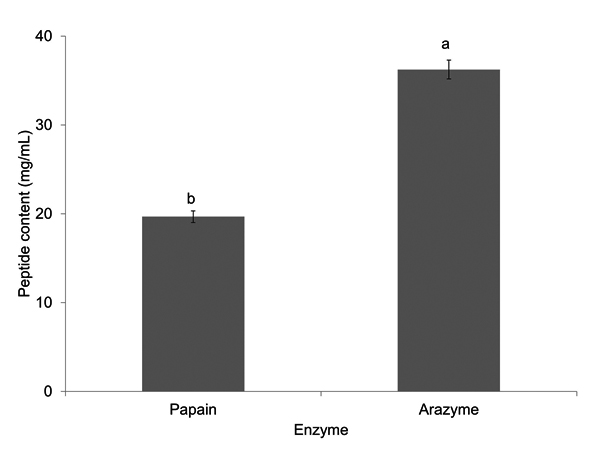
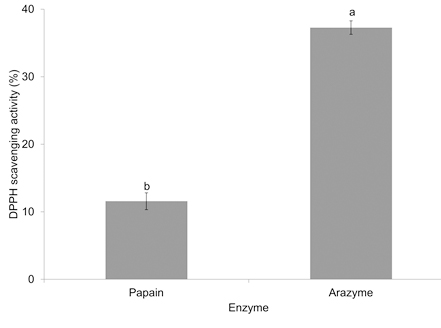 Fig. 1. Peptide content (A) and DPPH scavenging activities (B) of hydrolysates of roasted Eupolyphaga sinensis obtained from papain and arazyme. Different letters indicate significant differences (p<0.05). The vertical bars indicate standard deviation
Fig. 1. Peptide content (A) and DPPH scavenging activities (B) of hydrolysates of roasted Eupolyphaga sinensis obtained from papain and arazyme. Different letters indicate significant differences (p<0.05). The vertical bars indicate standard deviationEffect of HRES adding time on peptide content and DPPH scavenging activity of SSSEAP
Peptide content of HRES added soy sauce was significantly increased (145.33 mg/mL) when added at late-fermentation stage (Fig. 2A). DPPH radical scavenging activity of soy sauce with added HRES at different stages of fermentation was higher than that of control and reached 76.92% in late- fermentation (Fig. 2B).
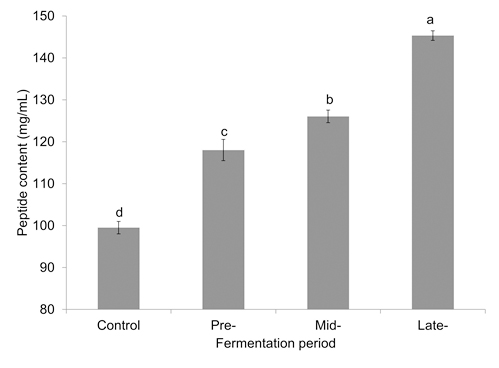
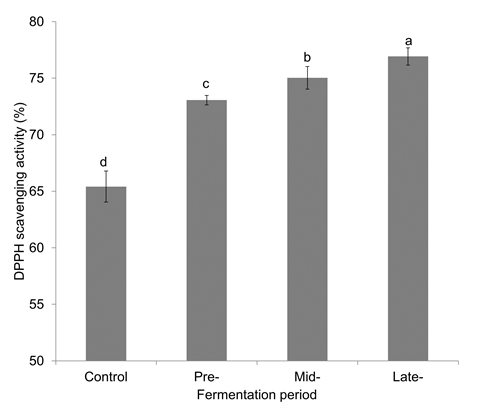 Fig. 2. Effect of 8% of hydrolysates of roasted Eupolyphagasinensis (HRES) adding time on peptide content (A) and DPPH scavenging activity (B) of soy sauce. Pre-, mid-, and late- fermentation period refer as the addition of HRES on first, tenth, and eighteenth day of soy sauce fermentation. Control refers to soy sauce without supplemented HRES. Different letters indicate significant differences (p<0.05). The vertical bars indicate standard deviation
Fig. 2. Effect of 8% of hydrolysates of roasted Eupolyphagasinensis (HRES) adding time on peptide content (A) and DPPH scavenging activity (B) of soy sauce. Pre-, mid-, and late- fermentation period refer as the addition of HRES on first, tenth, and eighteenth day of soy sauce fermentation. Control refers to soy sauce without supplemented HRES. Different letters indicate significant differences (p<0.05). The vertical bars indicate standard deviationSensory quality of SSSEAP
The highest score for sensory properties of SSSEAP reached when 8% HRES was added (data not shown). The soy sauce was bright red-brown, shiny, mellow, and clarified without any bad smell. The taste was also delicious and moderate salty. The second best was the soy sauce with a supplement of 13% HRES, followed by the 17% and 21% of HRES composition. When the added amount was increased to 21%, the taste became very light. Since the scores of sensory quality between the additions of 8% and 13% of HRES were very close, 8% of addition amount was considered for subsequent test.
Soluble unsalted solids content of SSSEAP
The soluble unsalted solids content of soy sauce increased significantly (p<0.05) with the addition of HRES (Fig. 3A). The soluble unsalted solids in soy sauce supplemented with 8% HRES reached 22.1 g/mL and was 1.7 times higher than that of control. The results indicated that 8% HRES effectively promote generation of soluble unsalted solids.
Amino acid nitrogen and total nitrogen content of SSSEAP
The results showed that amino acid nitrogen content in soy sauce supplemented with different amount of HRES (0.6-0.74 g/100 mL) was more than the control (0.57 g/100 mL) (Fig. 3B). Total nitrogen, which is another important index that represents quality and nitrogen utilization of soy sauce, also increased with added amount of HRES (1.5-1.83 g/100 mL) as compared to control (1.42 g/100 mL) (Fig. 3C).
Effect of HRES amount on peptide content and DPPH scavenging activity of SSSEAP
Peptide content of SSSEAP was increased considerably with the increasing amounts of HRES (Fig. 3D). It was increased rapidly from 0-8% and after 13% was slowed down. It reached to 145.19 mg/mL when the soy sauce supplemented with 21% HRES and was 1.6 times more than the control. The DPPH radical scavenging activity of SSSEAP increased (75.69%) as compared to that of control (65.20%) when 20% of HRES was added (Fig. 3E).
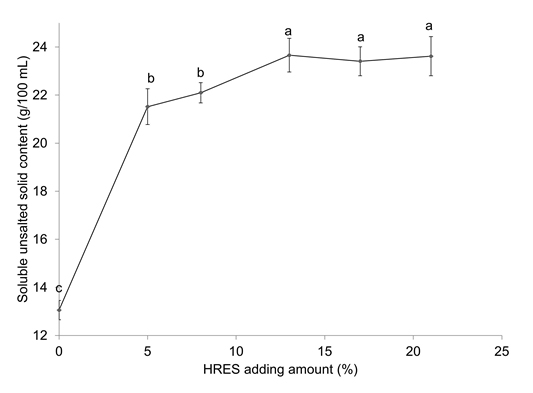
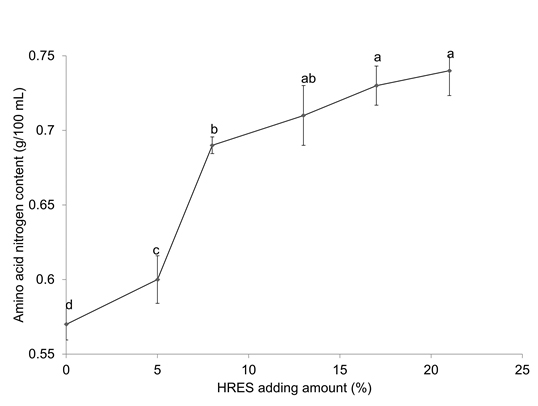
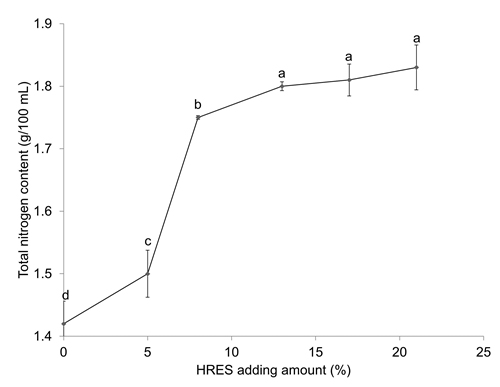
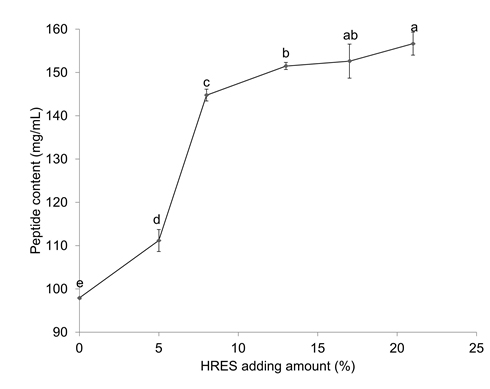
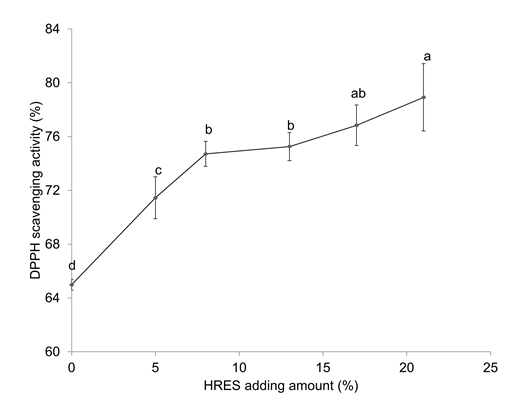 Fig. 3. Effect of hydrolysates of roasted Eupolyphaga sinensis (HRES) adding amount on soluble unsalted solids (A), amino acid nitrogen (B), total nitrogen (C), peptide content (D), and DPPH scavenging activity (E) of soy sauce. The HRES were added at late fermentation period of soy sauce. Different letters indicate significant differences (p<0.05). The vertical bars indicate standard deviation
Fig. 3. Effect of hydrolysates of roasted Eupolyphaga sinensis (HRES) adding amount on soluble unsalted solids (A), amino acid nitrogen (B), total nitrogen (C), peptide content (D), and DPPH scavenging activity (E) of soy sauce. The HRES were added at late fermentation period of soy sauce. Different letters indicate significant differences (p<0.05). The vertical bars indicate standard deviationFree amino acid and element content of SSSEAP
There were 18 amino acids in SSSEAP, out of which 6 were essential for human (data not shown). Glutamate (1.43 g/100 g) was the most abundantly found and G-aminobutyric acid (0.01 g/100 g) and hydroxylysine (0.01 g/100 g) contents were the lowest ones. The total amount of 6 essential amino acids in SSSEAP was 3.21 g/100 g, which was 40.02% of the total amino acids present. The amount of essential amino acids in control sample was 2.3 g/100 g. Amount of the umami amino acids in SSSEAP was 18.30% higher than in the control. The results of this study show that sodium content in SSSEAP was reduced by 21.82% than in control. It is an innovation of this study to meet the demand for low-salt soy sauce products. Other micro elements like copper, iron, magnesium, and zinc, which are necessary for normal functioning of human body, were also higher in SSSEAP than in control (data not shown).
Papain is derived from plants and is widely used as meat tenderizer, while arazyme is an efficient protease from insect. They were used in the present study for hydrolysis of roasted ES and their effects were assayed. HRES itself contains a large amount of peptide which could contribute to the higher peptide content in SSSEAP13. It is comprehensively used to evaluate antioxidant capacity in food industry. DPPH free-radical scavenging activity assay can be used for the primary characterization of the antioxidant potential of any food materials. The results of DPPH indicated that antioxidant activity of peptides was associated with amino acid sequence28. In addition; the fermentation process of SSSEAP, after adding HEES, may also release a lot of antioxidants to remove DPPH free radicals. Hence, SSSEAP contains higher peptide and stronger DPPH scavenging capacity than the soy sauce without HRES added during fermentation period. Peptide content of soy sauce with HRES added at late-fermentation stage was 1.46 times higher than that of control. Fermentation also can be divided into pre, main, and late fermentation. HRES was hydrolyzed by proteinase in pre and main fermentation period, which leads to a lower peptide content compared to the late fermentation. The changes in antioxidant activity could be attributed to variations in peptide content by adding HRES at different fermentation stages. The result corresponds to previous study29.
Sensory evaluation is a widely used method for determining the food quality. Light taste of soy sauce with the increased amount of HRES may be due to the reason that the HRES was converted into a number of bitter peptides during the soy sauce fermentation period because enzymatic hydrolysis frequently results in bitter taste30. The soy sauce itself is a spice with sour, sweet, bitter, umami, and salty tastes. These ingredients of tastes, except salt, are generated a lot in the form of soluble solid during the fermentation process. The amount of soluble unsalted solid, an important indicator of the quality of soy sauce judgment, refers to a difference derived after subtracting the salt content in the soy sauce. The amount of soluble unsalted solid in HRES added soy sauce in the present study was significant increased indicated high quality soy sauce could be produced.
During fermentation, amino acid nitrogen content is an important characteristic index of soy sauce26. It reflects the level of umami flavor and quality of soy sauce. Higher amount of amino acid nitrogen content in the HRES added soy sauce may be because of Maillard reaction31. The peptides produced during fermentation of HRES added soy sauce can not only give more delicious taste, but also improve the nutritional value of the soy sauce. In recent years, it has been reported that ES has anithrombotic, antitumor, immune-protective, and antioxidant properties9,32,33.
Amino acid nitrogen, one of the most important indicators of soy sauce quality, determines the quality grade of soy sauce in China24. The higher the nitrogen content in soy sauce, the higher the utilization of protein is, the better the quality is. Based on the Chinese standard of fermented soy sauce GB 18186-2000, SSSEAP could be classified into the first-class level by the evaluation of nitrogen content. The nutritional value of food protein depends largely on the amount and proportion of the essential amino acids that they provided for the synthesis of nitrogenous compounds34. Amino acids composition of SSSEAP also meets the FAO/WHO standard as it is recommended that the ideal protein pattern is the essential amino acids need to be around 40% of total amino acids. Aspartic acid, glutamic acid, glycine, and alanine could affect the umami and sweetness of the products, and these 4 amino acids were called umami amino acids34. The improvement of umami might be caused by free umami amino acids from ES, and it perhaps also depends on the composition and content of those amino acids. The results may infer that the amino acids of ES have an important contribution to taste composition of soy sauce.
Soy sauce is a salty seasoning having good nutrients profile. However, if the intake of sodium is too high, the osmotic pressure of extracellular fluid will be elevated, causing increased blood sodium, and aggravation of heart and kidney’s burden, leading to high blood pressure and heart diseases36. The soy sauce produced by using enzymatic hydrolysates of ES contained significantly low sodium than that in the control sample. The most abundant elements in SSSEAP was potassium and phosphorus as in the ES26.
This study combined enzyme technology with traditional low salt solid fermentation of soy sauce, in which high protein containing insect, ES was added. Results of the present study offer a good choice for antioxidant rich high quality soy sauce with low sodium content.
ACKNOWLEDGMENTS
This work was supported by the Qingdao Chunming Flavoring Co., Ltd from Qingdao Key Program of Enterprise Technology Innovation, China [grant numbers LX0901B2.0332].
- Mashilipa, C., Wang, Q., Slevin, M., Ahmed, N. Antiglycation and antioxidant properties of soy sauces. J. Med. Food 2011; 14: 1647–1653.
- Nagahara, A., Benjamin, H., Storkson, J., Krewson, J., Sheng, K., Liu, W., Pariza, M.W. Inhibition of benzo [a] pyrene-induced mouse forestomach neoplasia by a principal flavor component of Japanese-style fermented soy sauce. Cancer Res. 1992; 52: 1754–1756.
- Nakahara, T., Sugimoto, K., Sano, A., Yamaguchi, H., Katayama, H., Uchida, R. Antihypertensive mechanism of a peptide enriched soy sauce like seasoning: the active constituents and its suppressive effect on renin–angiotensin–aldosterone system. J. Food Sci. 2011; 76: H201–H206.
- Gao, X.L., Cui, C., Zhao, H.F., Zhao, M.M., Yang, L., Ren, J.Y. Changes in volatile aroma compounds of traditional Chinese-type soy sauce during moromi fermentation and heat treatment. Food Sci. Biotechnol. 2010; 19: 889–898.
- Zhao, G., Yao, Y., Wang, X., Hou, L., Wang, C., Cao, X. Functional properties of soy sauce and metabolism genes of strains for fermentation. Int. J. Food Sci. Tech. 2013; 48: 903–909.
- Zhou, Y.G., Ren, Y.C., Jiang, Y.X. Analysis of nutritional components of Eupolyphaga sinensis Walker. Food Res. Dev. 1998; 19: 51–53.
- Chuanhui, Y.I., Qiuju, H.E., Lin, W., Kuang, R. The utilization of insect-resources in Chinese rural area. J. Agr. Sci. 2010; 2: 146–154.
- Wang, Y., Yan, H., Wang, Y., Yang, H., Wei, L., Xiao, Y., Ye, H., Lai, R., Liu, R. Proteomics and transcriptome analysis coupled with pharmacological test reveals the diversity of anti-thrombosis proteins from the medicinal insect, Eupolyphaga sinensis. Insect Biochem. Mol. Biol. 2012; 42: 537–544.
- Wang, F.X., Wu, N., Wei, J.T., Liu, J., Zhao, J., Ji, A.G., Lin, X.K. A novel protein from Eupolyphaga sinensis inhibits adhesion, migration, and invasion of human lung cancer A549 cells. Biochem. Cell Biol. 2013; 91: 244–251.
- Najafian, L., Babji, A.S. A review of fish-derived antioxidant and antimicrobial peptides: their production, assessment, and applications. Peptides 2012; 33: 178–185.
- Samaranayaka, A.G., Li-Chan, E.C. Food-derived peptidic antioxidants: a review of their production, assessment, and potential applications. J. Funct. Foods 2011; 3: 229–254.
- Park, J.K., Jeong, D.H., Park, H.Y., Son, K.H., Shin, D.H., Do, S.H., Yang, H.J., Yuan, D.W., Hong, I.H., Goo, M.J., Lee, H.R. Hepatoprotective effect of arazyme on CCl 4-induced acute hepatic injury in SMP30 knock-out mice. Toxicology 2008; 246: 132–142.
- Piao, M.-Z., Wang, M.-C., Wang, X.-D. Antioxidant activity of Eupolyphaga sinensis Peptides [J]. Food Sci. 2013; 34: 242–245.
- Watanapaisantrakul, R., Chavasit, V., Kongkachuichai, R. Fortification of soy sauce using various iron sources: sensory acceptability and shelf stability. Food Nutr. Bull. 2006; 27: 19–25.
- Huo, J., Yang, X., Piao, J., Gao, J., Miao, H., Yu, B., Lu, C., Chen, J. NaFeEDTA fortified soy sauce showed higher iron absorption rate in Chinese females. Biomed. Environ. Sci. 2007; 20: 126.
- Rafnsson, S.B., Dilis, V., Trichopoulou, A. Antioxidant nutrients and age-related cognitive decline: a systematic review of population-based cohort studies. Eur. J. Nutr. 2013; 52: 1553–1567.
- Sila, A., Sayari, N., Balti, R., Martinez-Alvarez, O., Nedjar-Arroume, N., Moncef, N., Bougatef, A. Biochemical and antioxidant properties of peptidic fraction of carotenoproteins generated from shrimp by-products by enzymatic hydrolysis. Food Chem. 2014; 148: 445–452.
- Bryant, A.M., Davis, J., Cai, S., Singh, B.R. Molecular composition and extinction coefficient of native botulinum neurotoxin complex produced by Clostridium botulinum hall A strain. Protein J. 2013; 32: 106–117.
- Smith, P., Krohn, R.I., Hermanson, G.T., Mallia, A.K., Gartner, F.H., Provenzano, M., Fujimoto, E.K., Goeke, N.M., Olson, B.J., Klenk, D.C. Measurement of protein using bicinchoninic acid. Anal. Biochem. 1985; 150: 76–85.
- Chen, D., Fan, J., Wang, P., Zhu, L., Jin, Y., Peng. Y., Du, S. Isolation, identification and antioxidative capacity of water-soluble phenylpropanoid compounds from Rhodiola crenulata. Food Chem. 2012; 134: 2126–2133.
- Zheng, J., Wu, C.D., Huang, J., Zhou, R.Q., Liao, X.P. Analysis of volatile compounds in Chinese soy sauces moromi cultured by different fermentation processes. Food Sci. Biotechnol. 2013; 22: 605–612.
- Jeon, B.Y., Joo, D.H., Park, D.H. Chemical and biochemical characterization of Doenjang (Korean soy paste) supplemented with glasswort (Salicornia herbacea L.) and rice (Oryza sativa L.). J. Food Sci. Eng. 2012; 2: 283.
- Miyagi, A., Nabetani, H., Nakajima, M. Decolorization of Japanese soy sauce (shoyu) using adsorption. J. Food Eng. 2013; 116: 749–757.
- Ouyang, Q., Chen, Q., Zhao, J., Lin, H. Determination of amino acid nitrogen in soy sauce using near infrared spectroscopy combined with characteristic variables selection and extreme learning machine. Food Bioprocess. Tech. 2013; 6: 2486–2493.
- Vilasoa-Martínez, M., Lopez-Hernandez, J., Lage-Yusty, M.A. Protein and amino acid contents in the crab, Chionoecetes opilio. Food Chem. 2007; 103: 1330–1336.
- Latif, S., Pfannstiel, J., Makkar, H.P.S., Becker, K. Amino acid composition, antinutrients and allergens in the peanut protein fraction obtained by an aqueous enzymatic process. Food Chem. 2013; 136: 213–217.
- Horax, R., Hettiarachchy, N., Kannan, A., Chen, P. Proximate composition and amino acid and mineral contents of Mormordica charantia L. pericarp and seeds at different maturity stages. Food Chem. 2010; 122: 1111–1115.
- Chen, H.M., Muramoto, K., Yamauchi, F., Fujimoto, K., Nokihara, K. Antioxidative properties of histidine-containing peptides designed from peptide fragments found in the digests of a soybean protein. J. Agr. Food Chem. 1998; 46: 49–53.
- Singh, S., Swain, S., Singh, D.R., Salim, K.M., Nayak, D., Roy, S.D. Changes in phytochemicals, anti-nutrients and antioxidant activity in leafy vegetables by microwave boiling with normal and 5% NaCl solution. Food Chem. 2015; 176: 244–253.
- Lovsin-Kukman, I., Zelenik-Blatnik, M., Abram, V. Bitterness intensity of soybean protein hydrolysates—chemical and organoleptic characterization. Z. Lebensm Unters Forsch. 1996; 203: 272–276.
- Shahidi, F., Ho, C.T. (eds): Flavor and Chemistry of Ethnic Foods. Boston: Kluwer Academic/Plenum Publishers; 1999.
- Tang, Q., Dai, Y., Liu, X. Immunomodulatory effects of orally administered aqueous extract from Eupolyphaga sinensis Walker. Afr. J. Biotechnol. 2015; 9: 8682–8686.
- Lv, C.P., Li, X.Y., Yang, X.S., Guo, Q.Y. Quality evaluation of Antarctic krill sauce. Sci. Tech. Food Ind. 2012; 11: 033.
- Meneton, P., Jeunemaitre, X., de Wardener, H.E., Macgregor, G.A. Links between dietary salt intake, renal salt handling, blood pressure, and cardiovascular diseases. Physiol. Rev. 2005; 85: 679-715.
© The Author(s) 2016. Open Access. This article is distributed under the terms of the Creative Commons Attribution 4.0 International License which permits unrestricted use, sharing, distribution, and reproduction in any medium, provided you give appropriate credit to the original author(s) and the source, provide a link to the Creative Commons license, and indicate if changes were made.


